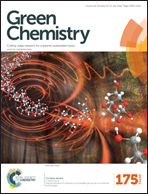Selective hydrogenation of lignin to produce chemical commodities by using a biochar supported Ni–Mo2C catalyst obtained from biomass†
Abstract
Catalytic hydrogenation of lignin to produce chemical commodities can significantly decrease the consumption of fossil fuels. However, the conversion efficiency, cost, and product selectivity using conventional catalysts are still unsatisfactory. In this study, we expediently prepared a mesoporous carbon supported Ni–Mo2C catalyst by one-pot fast pyrolysis of Ni–Mo preloaded sawdust and demonstrated its catalytic performance for hydrogenation of lignin. The as-prepared catalyst exhibited excellent catalytic performance in highly efficient and selective hydrogenation of lignin in the presence of H2 and isopropanol. Under mild reaction conditions (temperature of 250 °C, 2 h and 2.0 MPa initial H2 pressure), 61.3 wt% of lignin can be catalytically converted to liquid products, 80 wt% of which are phenols, guaiacols, and trimethoxybenzenes. The conversion rate of lignin remained at around 60% after recycling five times, indicating the good stability and reusability of the Ni–Mo2C/C catalyst. The high catalytic performance of Ni–Mo2C/C toward lignin hydrogenation may be attributed to the synergistic effect of the graphitized biochar matrix and the Ni–Mo2C nanoparticles which facilitates electron transfer.


 Please wait while we load your content...
Please wait while we load your content...